Ever wondered how to unlock the power of AI and use it for your explorations or projects? You may have heard of the OpenAI Playground and are curious about what it can do and how you can use it.
If so, you've come to the right place. This comprehensive guide AIms to illuminate the functionalities of the OpenAI Playground, from the basics to more complex operations. Whether you're a beginner stepping into AI or a developer looking for an in-depth understanding, this guide provides the insights you need to use the OpenAI Playground effectively. Let's dive in!
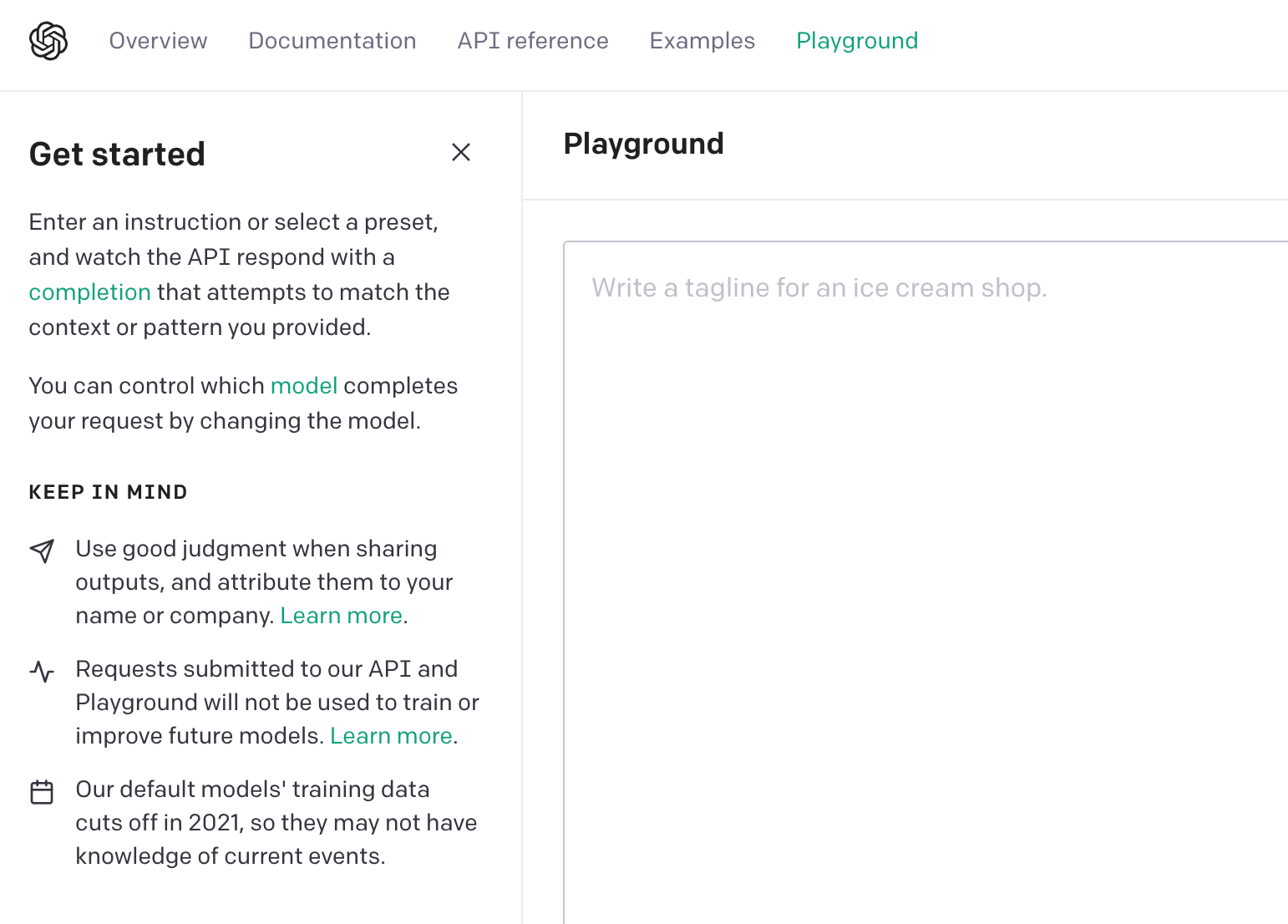
OpenAI Playground Screenshoot
1. Introduction to OpenAI Playground
1.1. What is OpenAI Playground?
OpenAI Playground is a dynamic web-based interface uniquely crafted for developers, researchers, and AI enthusiasts. This robust platform facilitates user interaction with OpenAI's cutting-edge models, including the powerfully intuitive GPT-3, allowing hands-on exploration of artificial intelligence and its practical applications. After many times of fine-tuning, Playground now supports more targeted adjustments in detAIl so that users can get the most satisfactory results in their interaction.
Playground not only serves as a sandbox for creativity and exploration but also acts as a practical tool for AI research and application development. The high degree of model customization it offers allows users to fine-tune existing models or trAIn new ones using their datasets, empowering tAIlored AI solutions for specific requirements.
Central to the OpenAI Playground is its interactive text input interface. This feature allows dynamic engagement with AI models, providing valuable insights into text processing and generation. Users can select between various modes for interaction, such as the Chat mode for dialogues, Q&A mode for targeted questions, and even request creative tasks like story writing or idea generation for activities.
Playground also comes with a variety of modes and parameters that enhance the user experience by tweaking countless other customizable options. For example, you can:
Enter pre-existing text for AI to edit,
Use temperature to control the randomness of the response,
Adjust the frequency to control its corresponding degree of repetition.
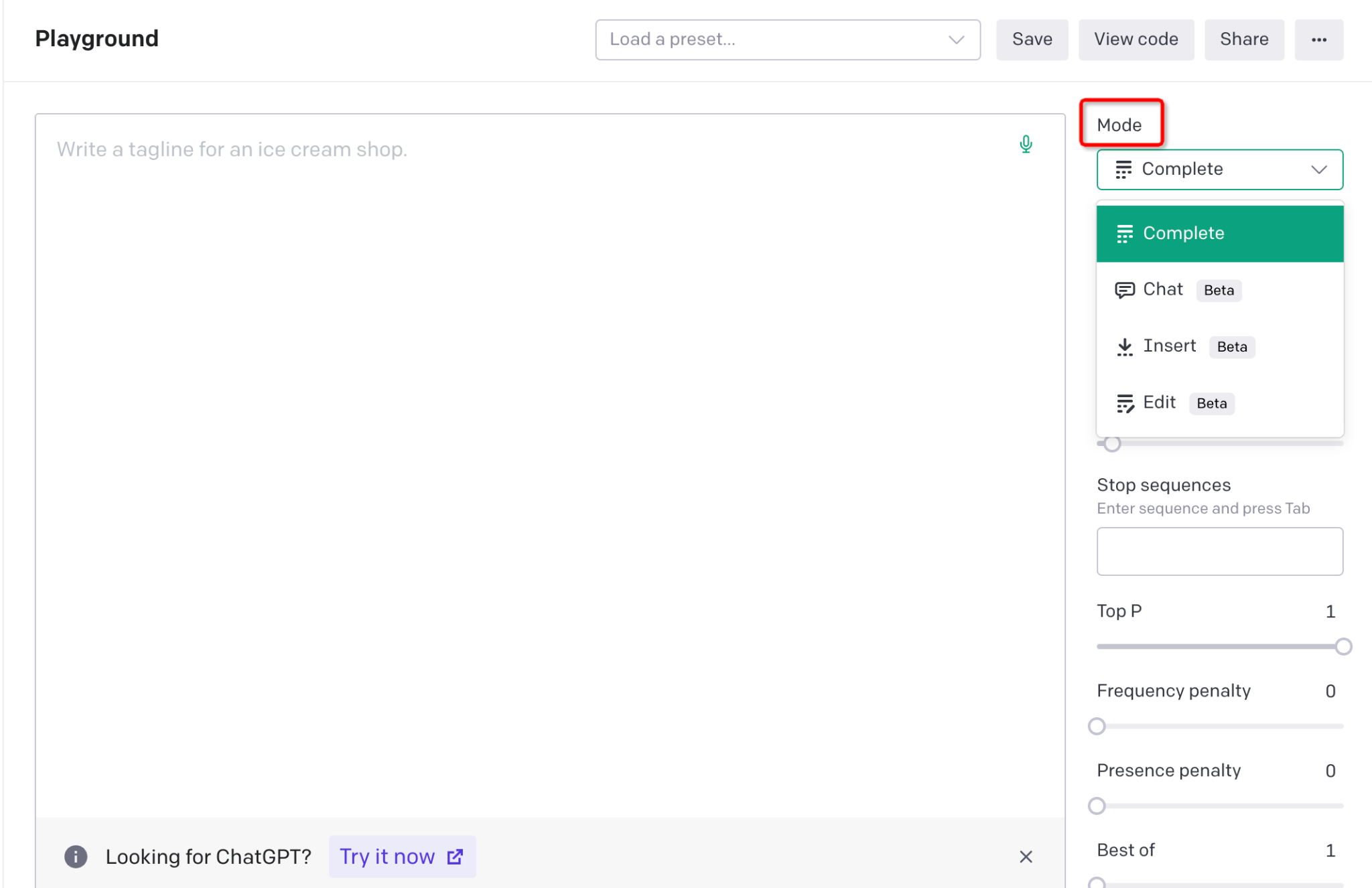
OpenAI Playground Adjustable Modes And Parameters

OpenAI Playground Adjustable Modes And Parameters
In conclusion, OpenAI Playground, with its diverse functionalities and user-centric design, democratizes access to the realm of artificial intelligence. Its commitment to providing an accessible platform for experimentation and learning not only propels innovation but also encourages new discoveries in the captivating field of AI.
1.2. Brief Comparison with ChatGPT
While OpenAI Playground and ChatGPT are both impressive projects of OpenAI, they cater to different needs and use cases. ChatGPT is focused on simulating human-like conversations, allowing users to engage with the AI in a natural language dialogue.
The ChatGPT platform is known for its ability to generate content from trAIning data such as writing and translation. It is a user-friendly tool for a wider audience. Whether crafting marketing copy or seeking a bodybuilder's diet plan, ChatGPT provides the accurate solutions you need from its vast knowledge base.
In contrast, OpenAI Playground has more features than dialogue and generated content. It is more suitable for technicians to use it to develop technology and research. With it, users can fine-tune different machine-learning models and tune them with custom datasets. This kind of ability is often used to build machine learning-based applications.
In short, although there are differences between these two tools, they can greatly help people improve creativity and efficiency and promote the progress of artificial intelligence.
2. OpenAI Playground Pricing
OpenAI Playground initially provides users an $18 credit for free, which supports interactions with its models.
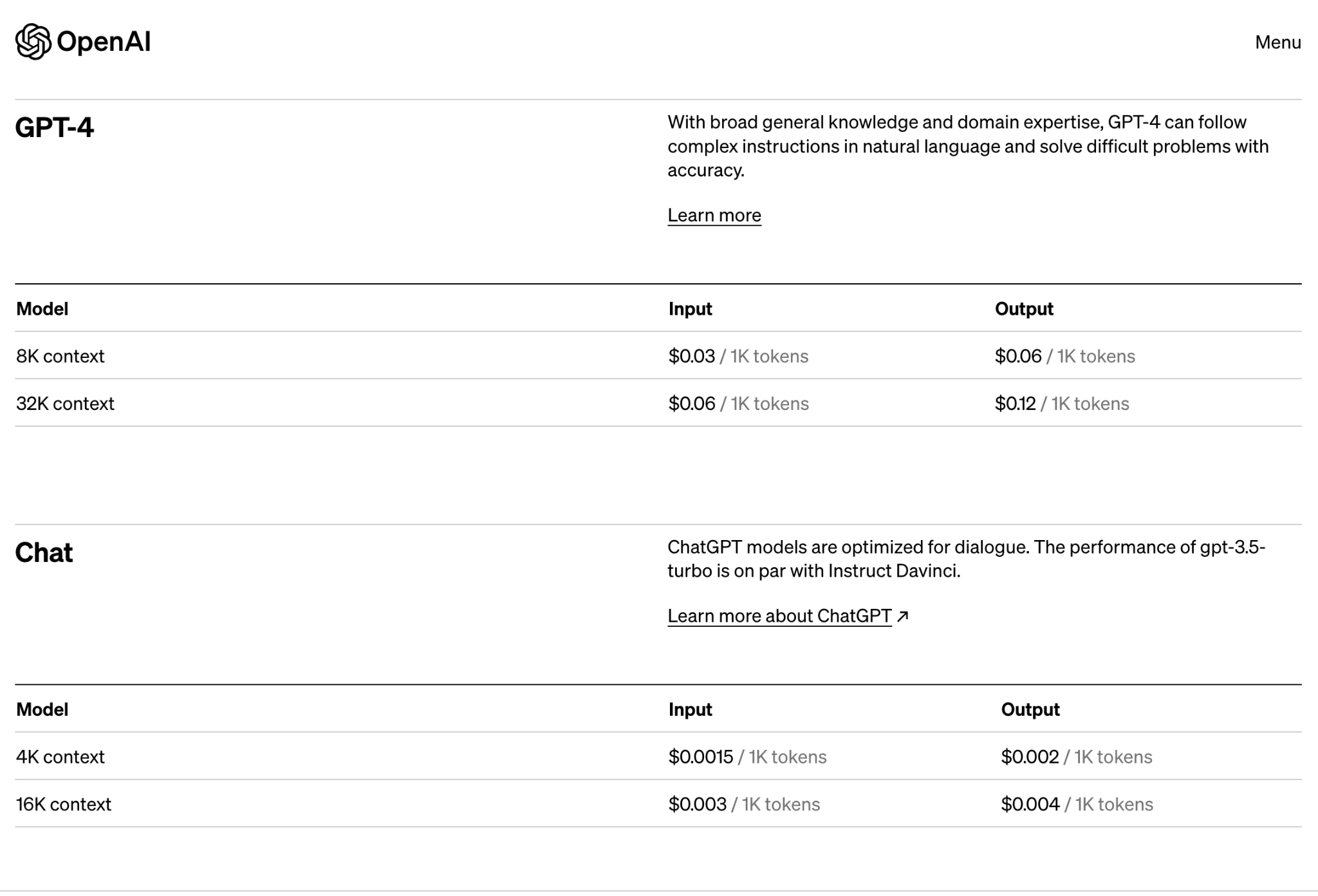
OpenAI Pricing Tokens
However, the free trial has an expiry date. After about three months, you need to subscribe to get tokens to continue using. Tokens refer to what OpenAI uses to count your usage, i.e., groups of words or characters used in prompts and AI responses.
Once you decide to subscribe, $5 will be held on your card, followed by monthly charges based on usage. If you want to use advanced models such as ChatGPT 4 Playground, you may need an additional subscription, such as ChatGPT Plus, which currently costs $20 per month.
3. Core Features of OpenAI Playground
OpenAI Playground offers several features that enhance the experience and versatility of interacting with AI models. These include:
3.1. Multiple Models:
OpenAI Playground supports a range of models with varying capabilities. These models include:
GPT-4 Limited beta: An improved set of models over GPT-3.5, understanding and generating natural language or code.
GPT-3.5: Models that improve upon GPT-3 with understanding and generating natural language or code capabilities.
DALL·EBeta: Can generate and edit images given a natural language prompt.
WhisperBeta: Converts audio into text.
Embeddings: Models that convert text into a numerical form.
Moderation: A fine-tuned model that can detect potentially sensitive or unsafe text.
GPT-3: Models that can understand and generate natural language.
CodexDeprecated: Models that can understand and generate code, including translating natural language to code.
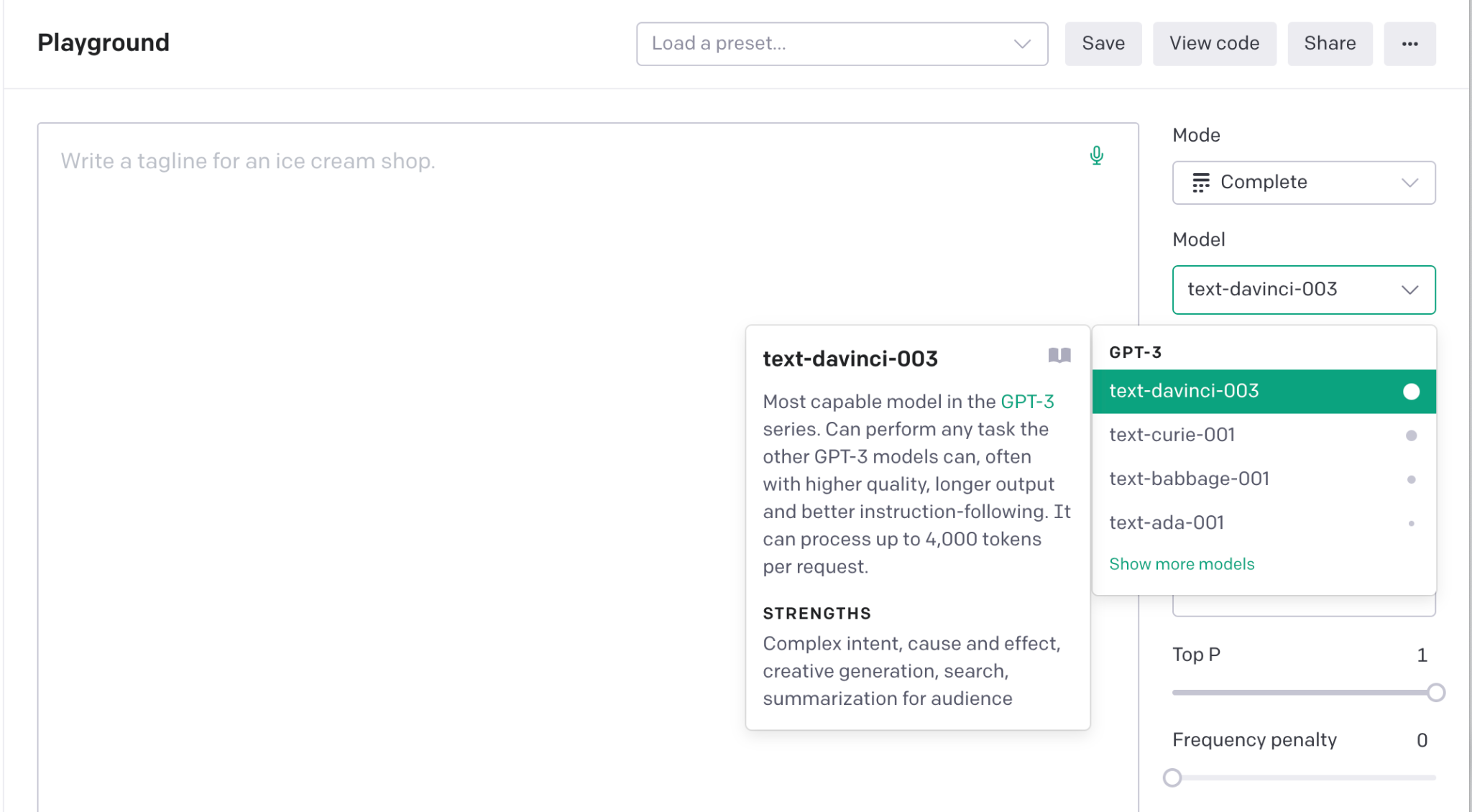
OpenAI Playground Models
Note: There are four commonly used models, namely Ada, Babbage, Curie, and Davinci. They differ in responsiveness and complexity. If these do not meet your needs, you can fine-tune these models for custom trAIning data. Note that the fine-tuned version is more expensive
3.2. Adjustable Parameters:
These parameters provide valuable control over the interaction with AI models and help users understand how they function.
Temperature Setting:
This factor is used to tune the decisiveness and creativity of the AI's responses. Note that this "temperature" has nothing to do with the temperature used in everyday life to describe physical temperature. The rules here are:
Lower temperature: the reaction is more concentrated and determined; you can try 0.2;
Higher temperature: more creativity and randomness; try it with "0.8".
Max Tokens Setting:
This setting allows users to determine the maximum length of the generated text.
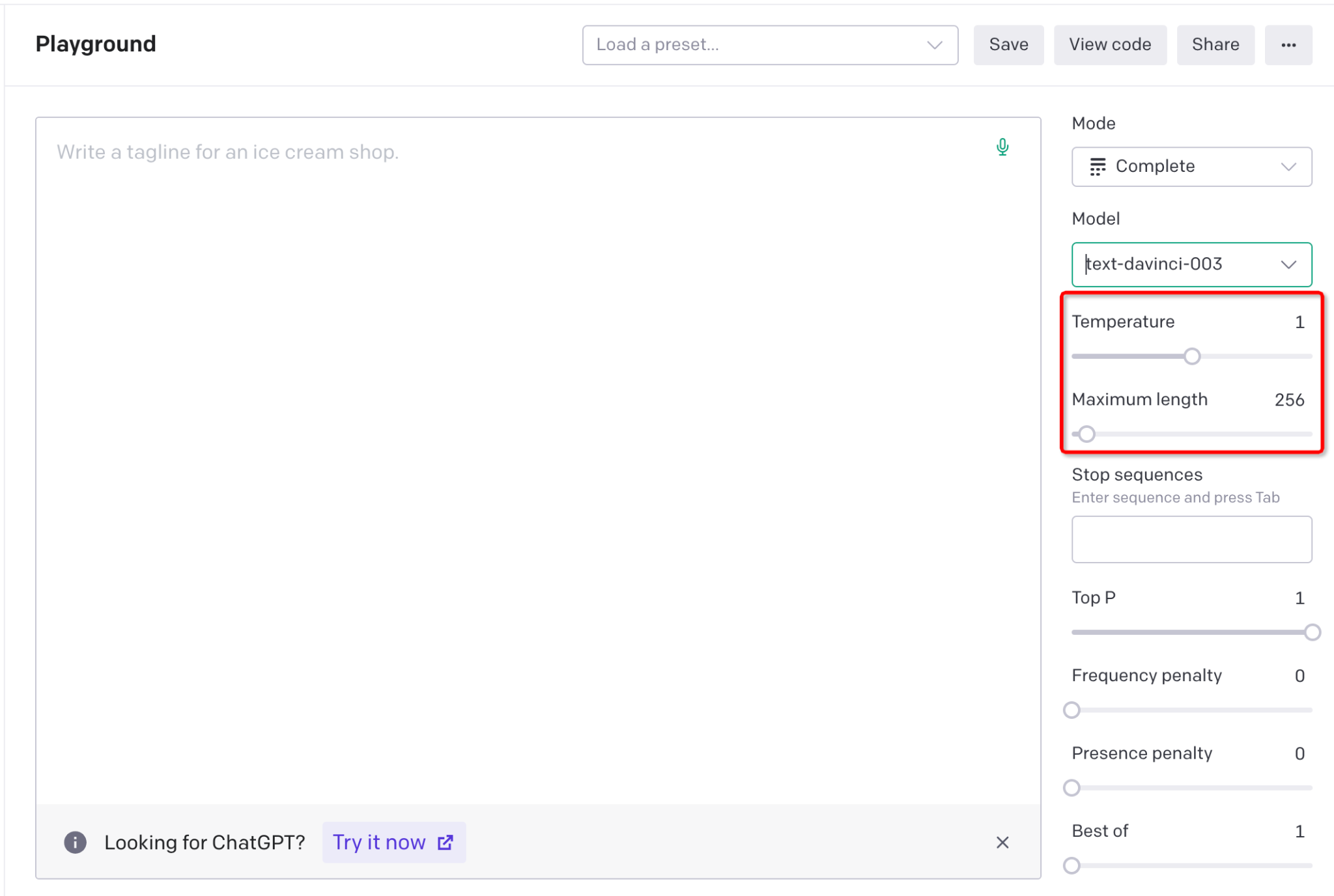
OpenAI Playground Adjustable Parameters Temperature And Maximum Length
3.3. Real-time Interaction:
With this parameter, OpenAI Playground will react to the user in real-time, which means it will output the user's text as soon as it receives it.
3.4. API Integration:
OpenAI Playground serves as a practical tool for developers by providing insights into the operation of the OpenAI API. It allows developers to understand and experiment with the API in a sandbox-like environment before integrating it into their applications.
4. How to Use OpenAI Playground
Here's how you can start using OpenAI Playground:
Step 1: Signing up for OpenAI Playground
Note: If you already have an OpenAI account, you can skip to step 2 and just click "Sign In" to use OpenAI Playground.
Navigate to OpenAI's API page and click "Sign Up" in the top-right corner.
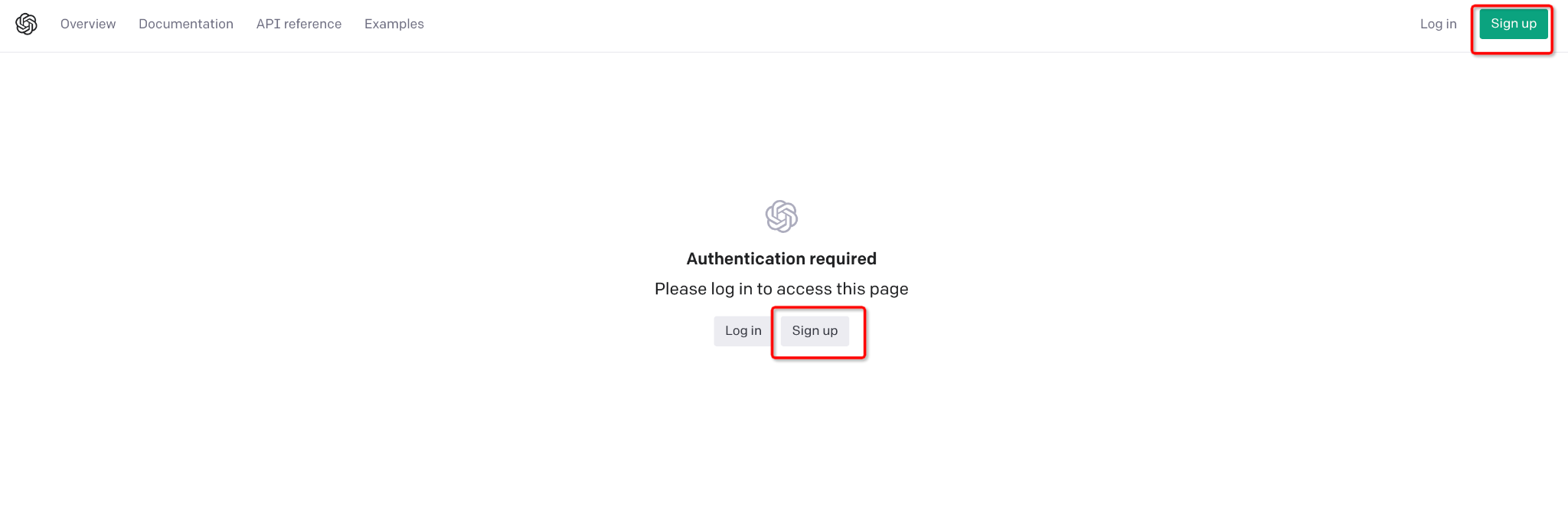
OpenAI Sign up
You can sign in with your Google or Microsoft account or register with a separate email address.
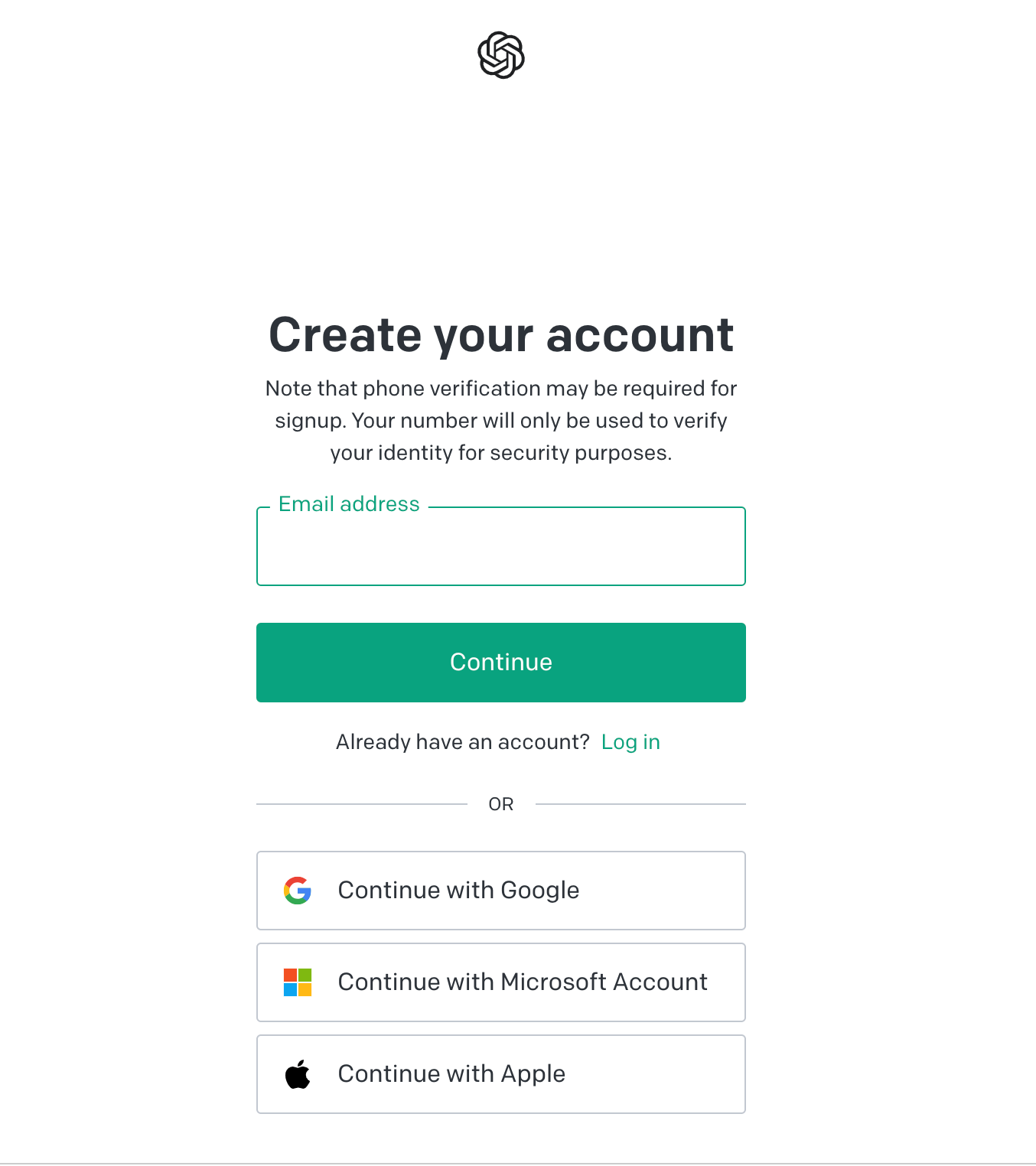
OpenAI Sign up with Email
Follow the sign-up instructions, which involve entering your email, and a valid mobile number and providing a reason for wanting to use OpenAI.
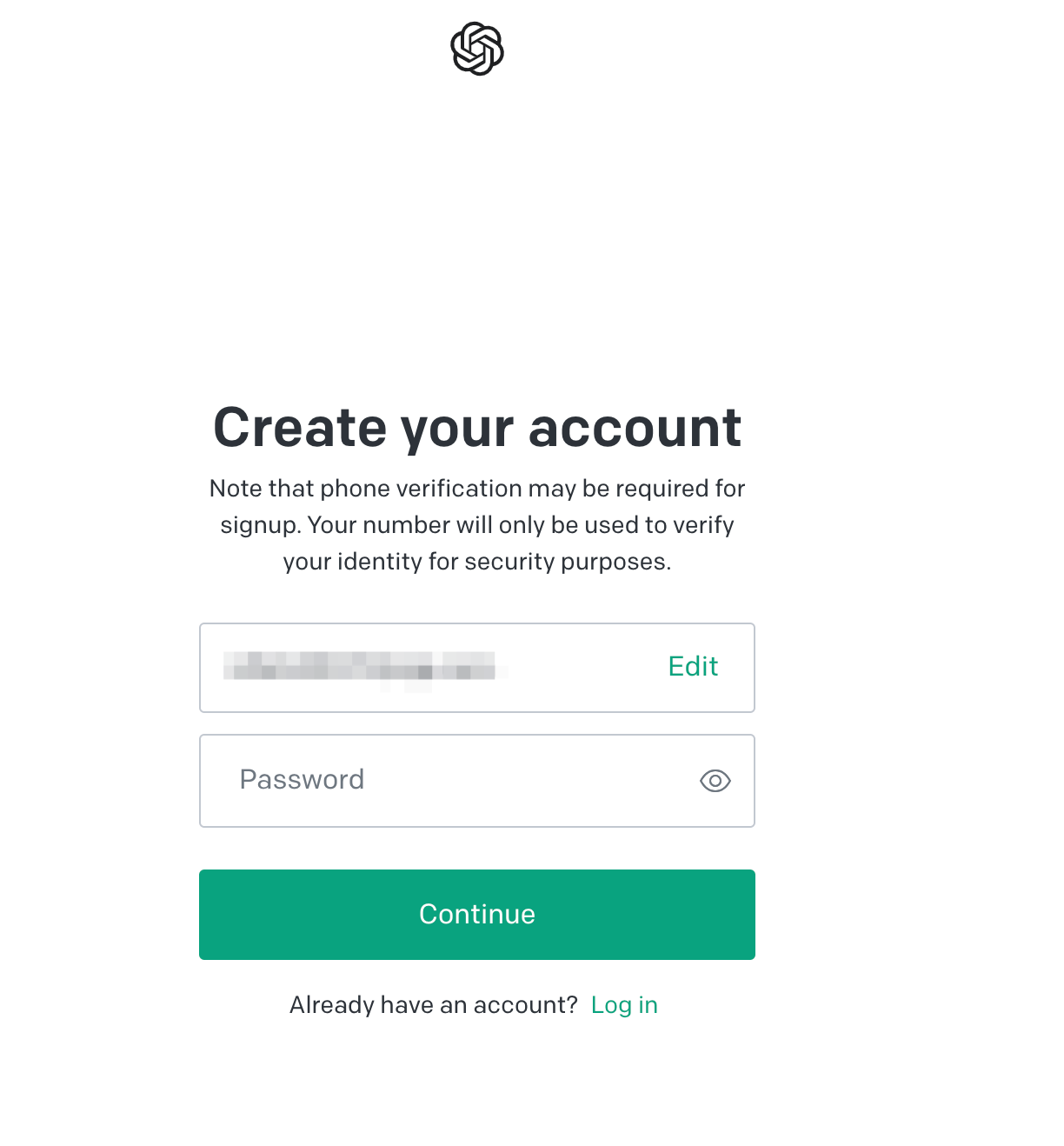
OpenAI Create Your Account
Once done, click "Playground" from the navigation menu at the top of the screen. This will take you to a page with a large text box and several adjustable settings on the sidebar.
Enter your name, organization (if applicable), and verify your phone number.
When asked how you'll primarily use OpenAI, choose the "I'm exploring personal use" option.
After this, you'll be directed to your OpenAI account's landing page. Choose"API."
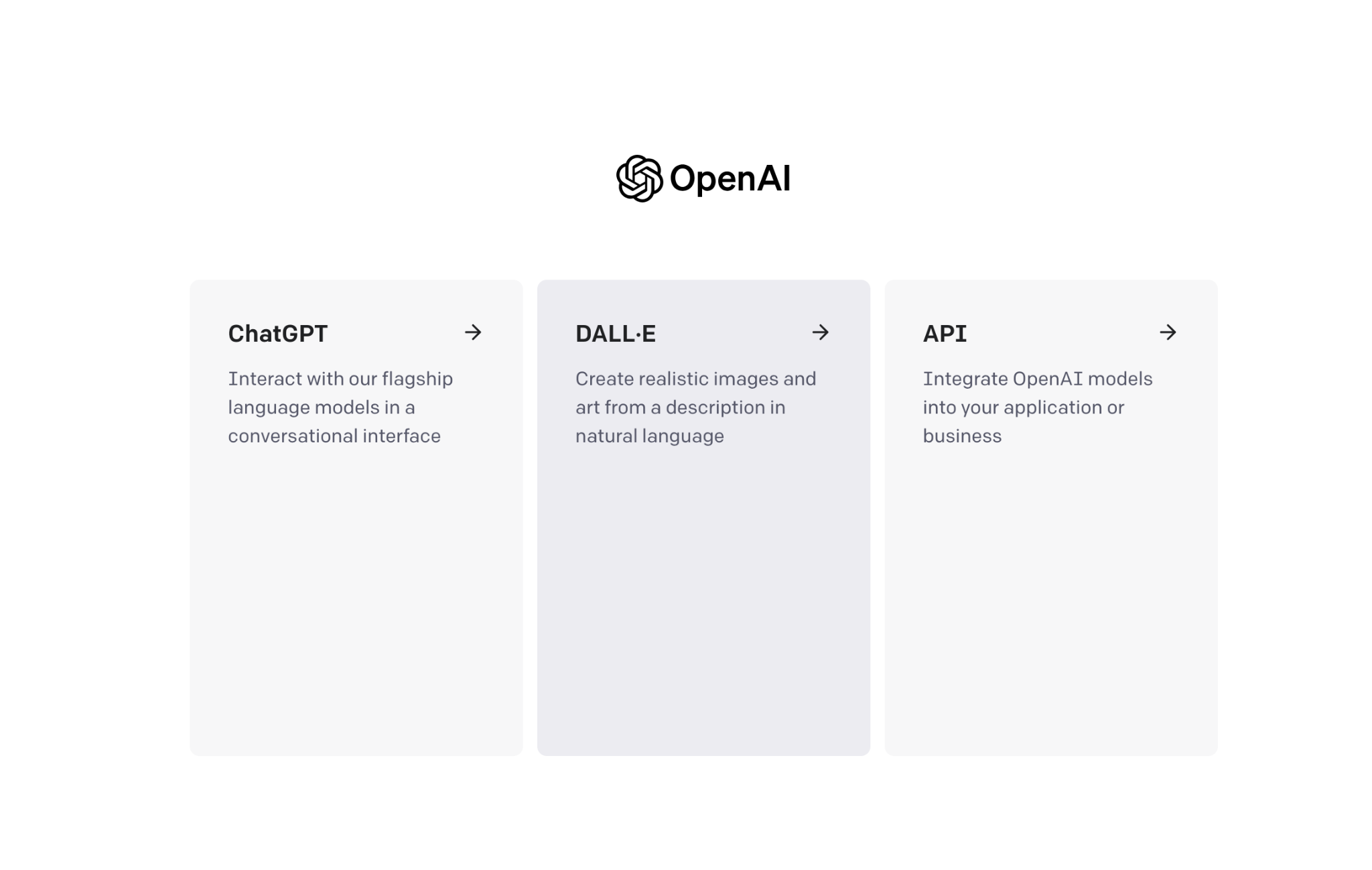
Open AI Landing Page Choose the Function
Click "Playground" at the top of the screen, and you'll have access to the Playground.

Open AI Menu Playground
Step 2: Submitting a Prompt
Type anything you want into the provided text box and click "Submit" at the bottom. The AI will respond to it after a few seconds, and anything the AI generates will be highlighted in green.
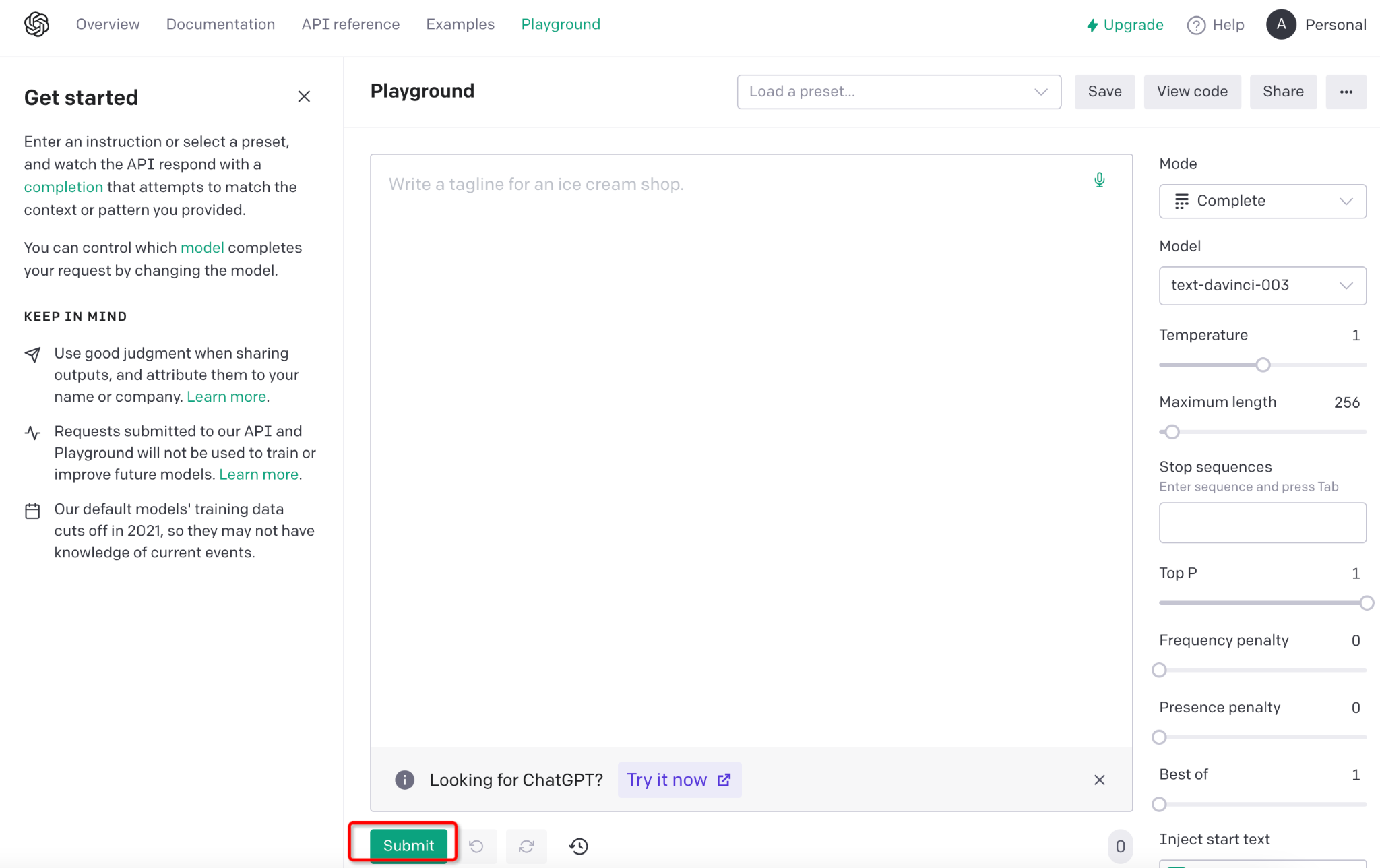
Open AI Playground Submit
You can experiment with various prompts, such as:
“Write a [Python] script to scrape data from a website and save it to a CSV file"
“Generate a [C++] code to implement a basic machine learning algorithm, such as linear regression"
“Rewrite this [Java] code into [Desired Language]"
“Write a [Python] script to implement a deep learning model for natural language generation"
“Create a [JavaScript] program to implement a basic chatbot using Dialogflow"
“Generate a [C#] code to create a basic AI game agent using A* algorithm"
Develop an architecture and code for a <website description> website with JavaScript.
I want to implement a sticky header on my website. Can you provide an example of how to do that using CSS and JavaScript?
If you need ideas, use the "Load a preset" drop-down menu in the top-right corner. These options provide ready-to-use prompts.
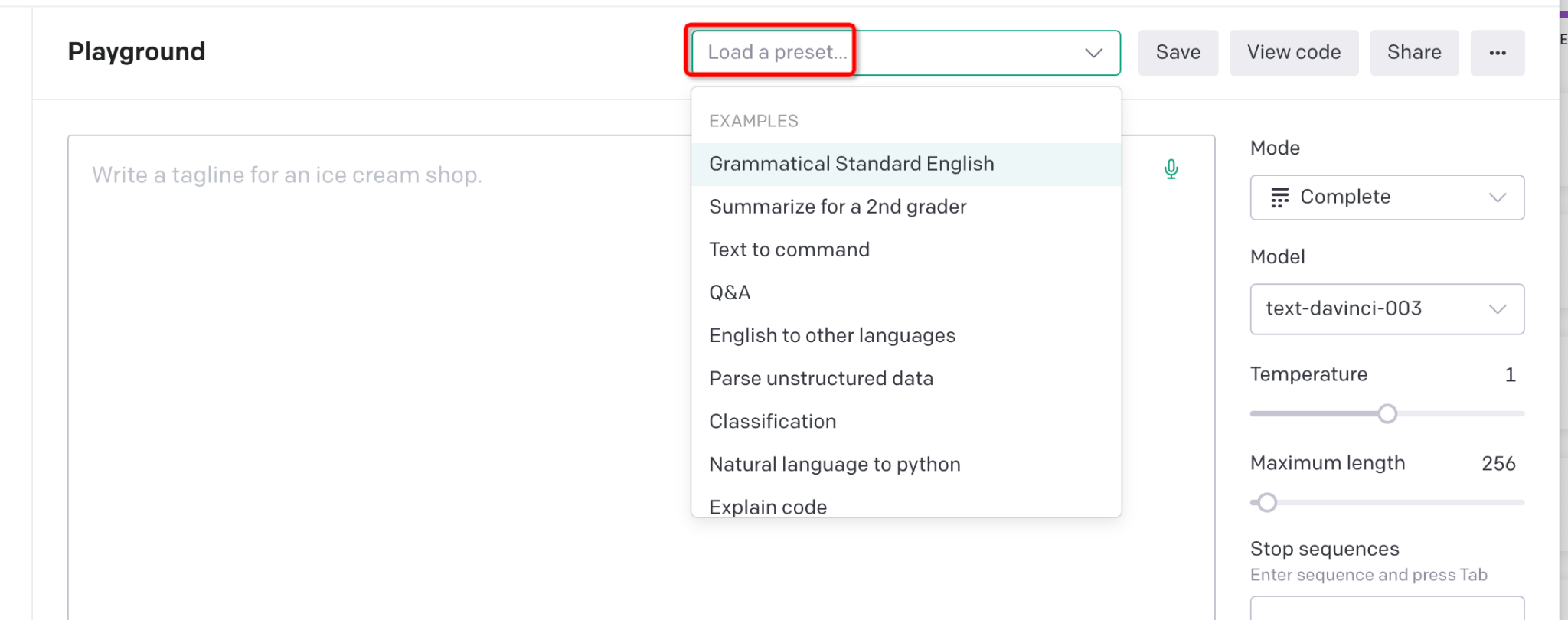
Open AI Menu Load A Preset
Note:
Remember, there are times when the AI might not give a definitive answer or respond to a prompt, especially if the questions are opinion-based or too broad.
5. Common Issues and Troubleshooting with ChatGPT Playground
ChatGPT Playground isn't exempt from occasional technical issues like any digital platform. Here are some problems you might encounter and suggestions for handling them:
Issues
1. Error Messages:
If you encounter an error message, check the code you entered for syntax or formatting errors. The official documentation provides code examples and guidelines which can be a helpful reference.
2. Unexpected Output:
If the chatbot provides unexpected or irrelevant responses, clear the conversation history and begin anew with a more specific prompt.
3. Connection Problems:
If you notice connectivity issues, you can check your internet connection. It will usually be back to normal after restarting the internet. If not, you can visit the official OpenAI status update page to see if any known issues are being resolved.
4. Model Delays:
ChatGPT Playground may occasionally experience delays in processing Q&A sessions. You can monitor the model's status to stay informed about any delays.
Remember, OpenAI continually works on improving user experiences, so you can expect these issues to be addressed over time.
Troubleshooting OpenAI GPT-3 Playground Issues
If you face difficulties while using the Playground, here are some troubleshooting steps:
1. Check OpenAI Playground Server Status:
A large number of users may cause instability in the OpenAI server. So the first step is to check whether OpenAI has reported the problem. If not, try the following.
2. Hard Refresh of the Page:
A quick and easy but effective method is a hard refresh.
For Windows: Press and hold Ctrl + F5 simultaneously.
For MacOS: Use Cmd + Shift + R together.
3. Clear Browser Cache and Cookies:
Clearing your browser cache and cookies can help resolve issues related to outdated data. Check your browser settings to clear browsing data.
4. Check Internet Connection:
A stable internet connection is necessary for the OpenAI Playground to function correctly. Troubleshoot your network or contact your ISP if you need connectivity issues.
5. Use a VPN:
Using a VPN might help resolve connectivity problems with the Playground.
6. Restart Your Device:
A simple restart can often resolve temporary glitches on your device.
7. Disable Ad-blockers or Browser Extensions:
Some ad-blockers or browser extensions might interfere with the OpenAI Playground. Temporarily disabling them might help.
8. Use Enter Instead of the "Submit" Button:
If you are unable to prompt with the button "Submit", try pressing "Enter" on your keyboard.
9. Try a Different Browser or Device:
If the Playground isn't loading, try using a different browser or device.
10. WAIt It Out:
As mentioned before, sometimes high demand can cause OpenAI servers to slow down or stop working. So if none of the above methods work, leave the dialog for a while and wait for the OpenAI staff to solve it.
6. Custom Instructions for ChatGPT
On July 21, 2023, OpenAI's ChatGPT released Custom Instructions, empowering users with more control over AI interactions. With it, you can set your preferences for all future dialogues, tailoring the AI's responses according to individual needs. This introduction will revolutionize user experience, making the AI model more context-aware and personal. Moreover, OpenAI also updates the privacy and safety measures to ensure user data is handled securely and responsibly.
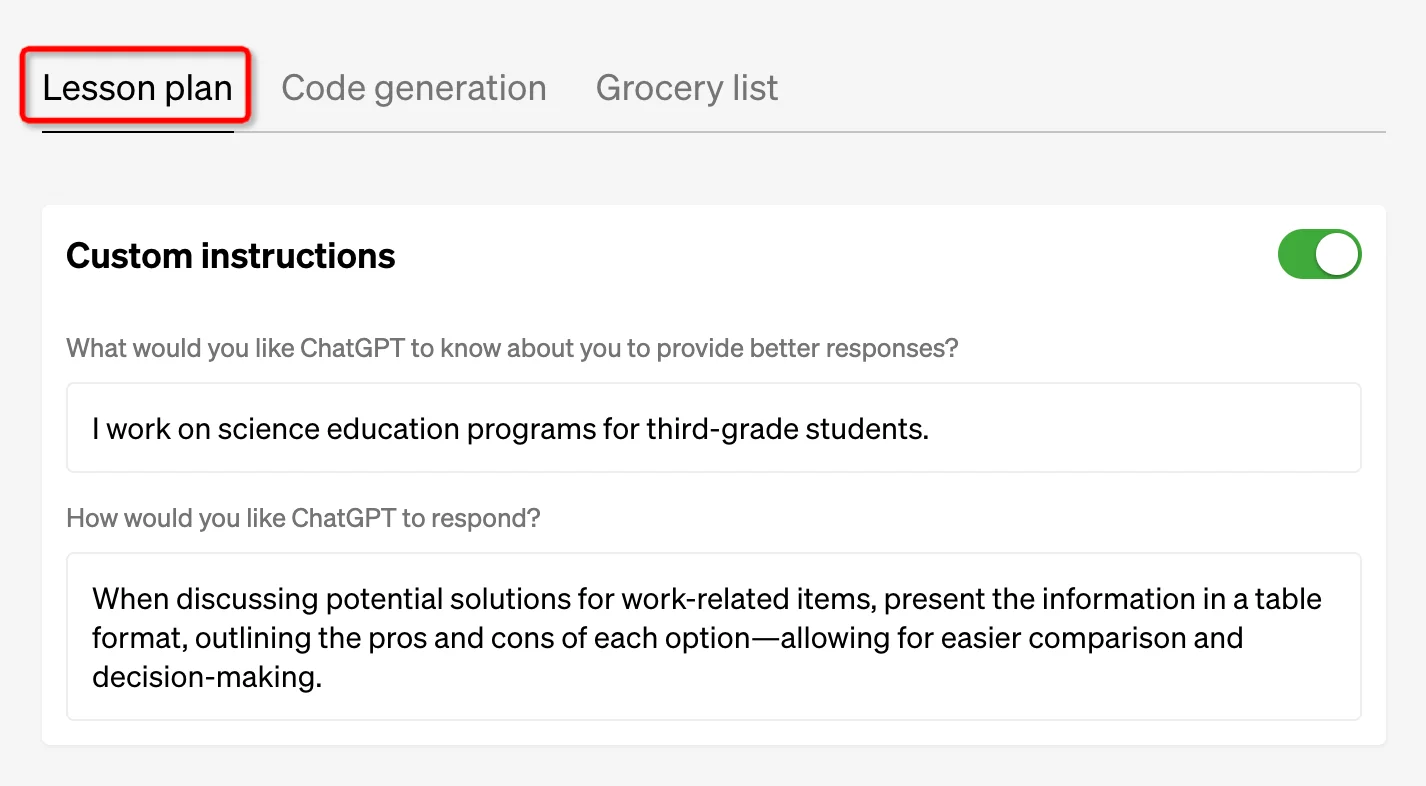
As of its release, only ChatGPT plus users can access it, and it’s not yet available in the UK and EU. But OpenAI’s tweet said it will be for everyone soon.
Steps to enable it:
Log in to the ChatGPT
Click your name → Settings → Beta features → opt into Custom Instructions.
On iOS, go to Settings → New Features → turn on Custom Instructions.
Note:
As of July 21, this feature is in its beta phase and may not always interpret instructions. OpenAI said they are committed to refining this process with user feedback.
7. Frequently Asked Questions (FAQs)
1. What Are the Example Applications of ChatGPT Playground?
ChatGPT Playground presents users with various example applications to make usage more efficient and productive. Some include 'Text to Command', which translates written text into programmatic commands, and 'Q&A', which facilitates asking questions and receiving prompt and relevant answers from the platform.
2. Is GPT-4 Available in OpenAI Playground?
As of now, GPT-4 is only available in OpenAI Playground for users with access to OpenAI's GPT-4 API.
GPT-4 introduced new features, including the capability to submit images to the model to comprehend, discuss, and respond to via text, making the system multi-modal. Given the novelty and potential of GPT-4, the wAItlist for its API is quite extensive.
Also, OpenAI may generally prioritize developers with innovative solid ideas to leverage its technology. Therefore, if you have not obtained the right to use the Playground of GPT-4, GPT3.5 is also a good choice.
Conclusion
We've now come to the end of our extensive guide on OpenAI's ChatGPT Playground. Now, you should have a basic understanding of OpenAI Playground to maximize the use of this technology, bringing out the capabilities of artificial intelligence for your projects.
The OpenAI's Playground is more than just a playground; it's a groundbreaking tool that opens up endless possibilities in the AI universe. As technology evolves, this guide will serve as a constant and reliable reference for you to return to. Embrace the capabilities of AI and explore new horizons with OpenAI Playground! Remember, the only limit is your imagination.